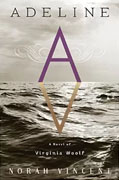Adeline
Norah Vincent
book reviews:
· general fiction
· chick lit/romance
· sci-fi/fantasy
· graphic novels
· nonfiction
· audio books
· author interviews
· children's books @
curledupkids.com
· DVD reviews @
curledupdvd.com
newsletter
win books
buy online
links
home
for authors
& publishers
for reviewers

 |
Adeline: A Novel of Virginia Woolf Norah Vincent Houghton Mifflin Harcourt Hardcover 288 pages April 2015 |
|
Moving from June 1925 to March 1941, Norah Vincent’s Adeline
In a tale that fluctuates between Virginia's earthly and spiritual worlds, the angst and the reality of her precious circumstances are as tempestuous as the sea’s ceaseless, torpid repetition. The shadow play of memory and time is etched and the dream language of light is made all too real. In her ethereal first-person narrative, Vincent portrays Virginia’s sudden obsession--Adeline, the bright Victorian girl she once was, shut behind dark paneled doors. Leading us though her quicksilver looking glass, the author tumbles us into the story of Virginia’s childhood by the sea in St. Ives and into her complex inner realms of emotion and thought.. The true magic of the book lies in the writing and the way all this is expressed. The language is uniquely lyrical, a deep reflection of Woolf's own words that almost paint pictures on the page. To some readers, many of these passages might seem grotesquely overwritten, but Vincent does this intentionally. She proclaims from the outset that this novel details Virginia’s everyday existence, enabling her to set up the elevated poetic language of her heroine and of T.S. Eliot and Eliot’s wife, Vivien; Virginia’s best friend, Lytton Strachey, and his wife, Dora Carrington; and of Lady Ottoline Morrell, the English aristocrat and society hostess who befriended many writers including Virginia and whose patronage was influential in London’s artistic and intellectual circles. By utilizing Woolf’s own colorful style, Vincent shows how Virginia intensely aligns herself with the Bloomsbury Group, such as her sister Vanessa Bell, Roger Fry, and Duncan Grant. There are many passages that might almost be a still-life by Grant, a perfect translation of Post-Impressionist painting into prose. Vincent, meanwhile, places us deep into Virginia’s mind: she recalls how her brother, Thoby, who died of typhoid tragically young, was her closest friend and confidante; how her marriage to Leonard sometimes feels like an “embattlement of foxholes;” and how her father’s Puritanism, harshness and morbid self-absorption are perhaps the reasons for her deep psychological problems: “still I come back to mind to these moments in the past.” Although some might find the novel pretentious and overwrought, I thought it was quite remarkable in its series of dramatic monologues that blend indistinguishably into one another. Woolf certainly was preoccupied with mortality, transience, loneliness, and the meaning of friendship. Her true crime is revealed to be not lack of life but of love, a crime for which Virginia herself was never able to show to anyone. At a crisis point and against the backdrop of another world war “buzzing and booming” all around them at close range, like “some cruel manifestation of her madness,” Virginia gives into her pain and walks behind her house, down to the River Ouse where she fills her overcoat pockets with rocks. The novel is a poetic paean to love, to a middle-aged woman's angst, and to the desperate, heart-wrenching luminosity of her wounded, long-suffering husband. Vincent’s beautiful, symbolic prose draws the reader into the lonely yearnings of this aging woman’s heart and into the all-consuming depression that finally claimed her life. Originally published on Curled Up With A Good Book at www.curledup.com. © Michael Leonard, 2015 |
| Also by Norah Vincent: |
|
|
|
 Click here to learn more about this month's sponsor! |
|
| fiction · sf/f · comic books · nonfiction · audio newsletter · free book contest · buy books online review index · links · · authors & publishers reviewers |
|
| site by ELBO Computing Resources, Inc. | |
 We
see her fanatically writing the outline of what will become The Lighthousee and also, later, The Waves. All comes alive in Virginia’s mind, coupled with the soothing finger and the unreachable caress of light in Leonard’s kind voice. As Leonard potters in the garden, where the plum trees need pruning and the vegetable plots need weeding, Virginia strides out with her demons “shouting their execrations to the air.” Her counterpoint is Adeline, who is also plagued by demons and speaks about the sadness of an uncle’s sexual consumption of her: “as if he had sucked the sadness through
her like a liquid meal.”
We
see her fanatically writing the outline of what will become The Lighthousee and also, later, The Waves. All comes alive in Virginia’s mind, coupled with the soothing finger and the unreachable caress of light in Leonard’s kind voice. As Leonard potters in the garden, where the plum trees need pruning and the vegetable plots need weeding, Virginia strides out with her demons “shouting their execrations to the air.” Her counterpoint is Adeline, who is also plagued by demons and speaks about the sadness of an uncle’s sexual consumption of her: “as if he had sucked the sadness through
her like a liquid meal.”